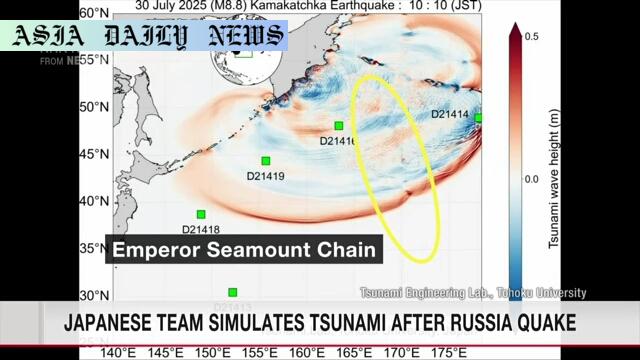Tsunami Simulation: Japanese researchers illustrate how underwater features altered tsunami waves post-Russian Far East quake.

Introduction to the Tsunami Simulation
Japanese researchers from Tohoku University’s International Research Institute of Disaster Science are breaking new ground in understanding tsunamis. Following a powerful earthquake in Russia’s Far East, their team, led by Professor Imamura Fumihiko, generated a real-time tsunami simulation to uncover why some of the most significant tidal waves took hours to materialize. The study focused on examining the changes in tsunami patterns caused by underwater geological structures, shedding light on unpredictable scenarios that can directly influence disaster preparedness.
The Role of the Emperor Seamount Chain
The pivotal finding of the study centers on the impact of the Emperor Seamount Chain—a series of underwater volcanic formations. When the initial tsunami waves generated by the quake reached this geological feature, they were disrupted and reflected. The simulation revealed that these reflected waves drastically altered the trajectory and intensity of the tsunami, eventually reaching Japan’s northeastern coast with considerable delays. For instance, Kuji Port on the Sanriku coast experienced a 1.3-meter tsunami over five hours post-quake, a phenomenon explained by the redirection and interaction of these waves with underwater barriers.
Understanding Unpredictable Tsunami Timelines
One of the most striking takeaways from the research is the inherent unpredictability of tsunamis. Unlike traditional systems where disaster response can rely on more linear cause-and-effect predictions, tsunamis are influenced by a complex interplay of geological and oceanic factors. Professor Imamura emphasized how difficult it can be to determine precisely when to issue and withdraw tsunami advisories. These challenges highlight the importance of continuous research and advanced simulation tools in preparing for future seismic events.
Practical Implications for Disaster Management
The findings from Tohoku University’s research go beyond academic curiosity. They have vital implications for disaster management policies, especially in regions prone to seismic activities. Accurate and dynamic simulations like this one can enhance early-warning systems, guide evacuation protocols, and inform coastal infrastructure planning. Importantly, the study serves as a reminder for residents in earthquake-prone areas to stay alert and follow real-time updates from reliable sources during such emergencies.
Conclusion: A Step Forward in Tsunami Preparedness
This groundbreaking simulation stands as a testament to the progress being made in natural disaster studies. By unlocking the secrets of delayed tsunami impacts, the Tohoku University research team has paved the way for better understanding and readiness in the face of complex natural phenomena. Moving forward, the integration of such advanced simulations into global disaster response systems could prove invaluable, saving lives and reducing damage caused by unpredictable events like tsunamis.
Commentary
The Ingenuity of Tsunami Simulations
The groundbreaking work by the researchers at Tohoku University highlights the critical role science plays in ensuring public safety. This tsunami simulation is more than a technological feat; it is a tangible demonstration of how research can save lives. By examining how underwater features like the Emperor Seamount Chain redirect and delay waves, the team has added a new dimension to understanding these natural disasters.
Challenges of Predicting Natural Disasters
As Professor Imamura rightly pointed out, tsunamis are inherently unpredictable. This complexity underscores the necessity of continuous advancements in technology and methodology. Understanding the delays and trajectories of tsunami waves is crucial, as such insights could guide more accurate advisory timelines. It is humbling to consider how even the most advanced systems must contend with nature’s unpredictability. Still, initiatives like this inspire hope for the future.
Broader Implications for Global Safety
The findings from this study have implications far beyond Japan. Coastal nations across the globe stand to benefit from this research, particularly those with vulnerable populations living near the water. If incorporated into global early-warning systems, advanced simulations like these could make tsunami forecasting not only faster but also more precise. It serves as a call for further investment in disaster science, emphasizing its universal value in protecting communities.
A Continuous Need for Awareness
While researchers work tirelessly behind the scenes, the general public has a critical role to play. Staying informed, being prepared, and trusting in the science underpinning advisory systems are essential steps. Rather than succumbing to complacency, every individual must recognize the value of such advancements and incorporate disaster preparedness into their lives. After all, the ultimate goal of projects like this is to ensure that everyone, everywhere, is safer when nature unleashes its power.


